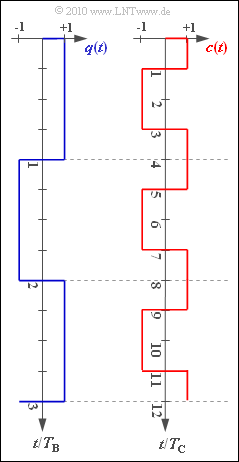Difference between revisions of "Aufgaben:Exercise 3.7Z: Spread Spectrum in UMTS"
From LNTwww
| Line 63: | Line 63: | ||
{{ML-Kopf}} | {{ML-Kopf}} | ||
| − | '''(1)''' | + | '''(1)''' Correct is the <u>solution 2</u>: |
| − | * | + | *For UMTS, the chip duration $T_{\rm C}$, which is still to be calculated in the subtask '''(2)''', is predefined. |
| − | * | + | *The greater the degree of spreading $J$, the greater the bit duration. |
| − | '''(2)''' | + | '''(2)''' According to the note on the information page, in $10 \ \rm ms$ exactly $15 \cdot 2560 = 38400 \ \rm Chips$ are transferred. |
| − | * | + | *With this the chip rate is $R_{\rm C} = 100 \cdot 38400 \ {\rm Chips/s} \ \underline{= 3.84 \ \rm Mchip/s}$. |
| − | * | + | *The chip duration is the reciprocal of this: $T_{\rm C} \ \underline{\approx 0.26 \ \rm µ s}$. |
| − | '''(3)''' | + | '''(3)''' Each data bit consists of four spreading chips ⇒ $\underline{J = 4}$. |
| − | '''(4)''' | + | '''(4)''' The bit rate is calculated with the spreading factor $J = 4$ zu $R_{\rm B} = R_{\rm C}/J \ \underline{= 960 \ \rm kbit/s}$. |
| − | * | + | * With the maximum spreading factor $J = 512$ for UMTS, the bit rate is only 5s $7.5 \ \rm kbit/s$. |
| − | '''(5)''' | + | '''(5)''' The following applies to the transmitted signal $s(t) = q(t) \cdot c(t)$. |
| − | * | + | *The chips $s_{3}$ and $s_{4}$ of the transmit signal belong to the first data bit ($q_{1} = +1)$: |
:$$s_3 = c_3 \hspace{0.15cm}\underline {= -1},\hspace{0.4cm}s_4 = c_4 \hspace{0.15cm}\underline {= +1}\hspace{0.05cm}.$$ | :$$s_3 = c_3 \hspace{0.15cm}\underline {= -1},\hspace{0.4cm}s_4 = c_4 \hspace{0.15cm}\underline {= +1}\hspace{0.05cm}.$$ | ||
| − | * | + | *On the other hand, the two other transmission chips sought are to be assigned to the second data bit $(q_{2} = -1)$: |
:$$s_5 = -c_5= -c_1 \hspace{0.15cm}\underline {= -1},\hspace{0.4cm}s_6 = -c_6= -c_2 \hspace{0.15cm}\underline {= +1}\hspace{0.05cm}$$ | :$$s_5 = -c_5= -c_1 \hspace{0.15cm}\underline {= -1},\hspace{0.4cm}s_6 = -c_6= -c_2 \hspace{0.15cm}\underline {= +1}\hspace{0.05cm}$$ | ||
Revision as of 21:25, 7 July 2020
For UMTS/CDMA, the so-called PN modulation is applied:
- The rectangular digital signal $q(t)$ is multiplied by the spread signal $c(t)$ and gives the transmit signal $s(t)$.
- This is by the spreading factor $J$ higher frequent (=more frequent) than $q(t)$; this is called band spreading.
At the receiver the same spreading signal $c(t)$ is added (namely in phase!). This reverses the band spreading ⇒ band compression
The diagram shows exemplary signal characteristics of $q(t)$ und $c(t)$.
Notes:
- This exercise belongs to the chapter Die Charakteristika von UMTS.
- Reference is made to the chapter Nachrichtentechnische Aspekte von UMTS in the book„Beispiele von Nachrichtensystemen”.
- For the calculation of the chip duration $T_{\rm C}$ , please refer to page Physikalische Kanäle .
- There you will find, among other things, the information important for this task, which is transmitted on the so-called Dedicated Physical Channel (DPCH) in ten milliseconds exactly $15 \cdot 2560 \ \rm Chips$ .
- In subtask (5), the system asks for transmit chips. For example, the "sending chip" $s_{3}$ denotes the constant signal value of $s(t)$ in the time interval $2T_{\rm C}$ ... $3T_{\rm C}$.
Questionnaire
Musterlösung
(1) Correct is the solution 2:
- For UMTS, the chip duration $T_{\rm C}$, which is still to be calculated in the subtask (2), is predefined.
- The greater the degree of spreading $J$, the greater the bit duration.
(2) According to the note on the information page, in $10 \ \rm ms$ exactly $15 \cdot 2560 = 38400 \ \rm Chips$ are transferred.
- With this the chip rate is $R_{\rm C} = 100 \cdot 38400 \ {\rm Chips/s} \ \underline{= 3.84 \ \rm Mchip/s}$.
- The chip duration is the reciprocal of this: $T_{\rm C} \ \underline{\approx 0.26 \ \rm µ s}$.
(3) Each data bit consists of four spreading chips ⇒ $\underline{J = 4}$.
(4) The bit rate is calculated with the spreading factor $J = 4$ zu $R_{\rm B} = R_{\rm C}/J \ \underline{= 960 \ \rm kbit/s}$.
- With the maximum spreading factor $J = 512$ for UMTS, the bit rate is only 5s $7.5 \ \rm kbit/s$.
(5) The following applies to the transmitted signal $s(t) = q(t) \cdot c(t)$.
- The chips $s_{3}$ and $s_{4}$ of the transmit signal belong to the first data bit ($q_{1} = +1)$:
- $$s_3 = c_3 \hspace{0.15cm}\underline {= -1},\hspace{0.4cm}s_4 = c_4 \hspace{0.15cm}\underline {= +1}\hspace{0.05cm}.$$
- On the other hand, the two other transmission chips sought are to be assigned to the second data bit $(q_{2} = -1)$:
- $$s_5 = -c_5= -c_1 \hspace{0.15cm}\underline {= -1},\hspace{0.4cm}s_6 = -c_6= -c_2 \hspace{0.15cm}\underline {= +1}\hspace{0.05cm}$$
